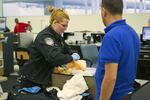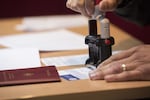Invasive species can move vast distances to find new habitats to colonize. However, they can't do it on their own. They need to hitch a ride.

CBP Agriculture Specialists process passengers who have food products in their luggage as they arrive to the United States.
James Tourtellotte / U.S. Customs and Border Protection
Humans create the pathways that allow invasive species to travel in ways they could never do under natural conditions. Invasive weeds, insects, even frogs and lizards find their way into cargo and containers that travel from one country to another. Invasive weed seeds get picked up on the soles of boots and on the hooves of horses and cattle. Aquatic weeds like hydrilla and water hyacynth and invasive shellfish like quagga mussels and zebra mussels often hitch rides on boats being trailered between distant waterways.
Understanding how our own mobility helps invasive species move is the first step in preventing their spread.
Attention Travelers! Attention shoppers!
Ever wonder what those agents from the U.S. Customs and Border patrol are doing as they wander around airport terminals? Well, in addition to looking for drugs and other suspicious activity, agents are tasked with searching bags and cargo for signs of invaders. That's why all passengers are asked to fill out those little declaration forms as they re-enter the United States — to keep invaders out.

Officers with the U.S. Customs and Border Protection, Office of Field Operations, board a flotilla of tall ships off the Coast of Boston, Massachusetts, to conduct customs inspections of the visiting vessels and crews, June 16, 2017.
Glenn Fawcett / U.S. Customs and Border Protection
Customs officials will sometimes confiscate food items or souvenirs that you've brought home from your overseas vacation. Prohibited agricultural items can hide foreign animal and plant pests and diseases that could cause serious damage to our environment and economy.
You'll also find Customs "agricultural specialists" making the rounds at ports and shipyards inspecting containers full of consumer goods. They're there because packing materials for consumer goods are sometimes infested with wood boring pests and potentially invasive insects like gypsy moths and Asian long-horned beetles.